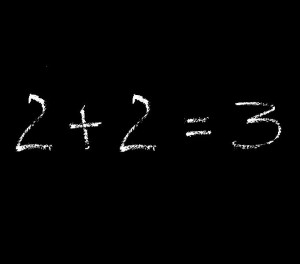Is Your Math Really as Bad as M.I.T., Harvard and Princeton Students’?

How much is the expense account? [Pause.]
$20,000—right? Apparently not, according to a recent study that reports 50% of Harvard, Princeton and MIT undergraduate students gave a comparable answer to a similar problem and got it wrong.
In that study, the question was, “What is the cost of a ball, if a bat and ball together cost $1.10 and the bat costs $1 more than the ball?” The incorrect answer: $0.10. Correct answer: $0.05. Or so the researchers claim.
Wait! You think, “The total package is $70,000; the salary is $50,000 more than the expense account. So, that’s $50,000 more than $20,000. Hence, the expense account has got to be $20,000!”
But do the math—really do the math, but do it the way the researchers want you to, like this:
[Note: The bat and ball problem in the university study is dealt with by the researchers in the same way.]
1. Package = $70,000 = S + E [S is salary; E is expense account]
2. S = E + $50,000
3. Therefore, $70,000 = S + E = E + ($50,000 + E) [by substitution from step 2]
4. Therefore, $70,000 = 2E + $50,000
5. Therefore, $70,000-$50,000 = 2E
6. Therefore, $20,000 = 2E
7. Therefore, E = $10,000 [not $20,000].
Check: Remember, the salary is $50,000 more than the expense account. So, if the expense account is $10,000, the salary is $10,000 plus another $50,000, i.e., is $50,000 more than the $10,000. That is, the salary is $60,000—not $50,000.
Expressing this algebraically, we get this:
1. 1. $70,000 = S + E and E = $10,000 [not $20,000]
2. 2. Therefore, $70,000 = S + $10,000
3. 3. Therefore, S = $60,000 [not $50,000]
This means that you may not be able to deliver the expense account you or the applicant thinks you or the employer is promising—a case of more as less.
Feeling Dumb or Smug?
Feel dumb? Don’t. I don’t, even though I, like half of the Harvard, Princeton and MIT students, initially said “$0.10” was the correct ball and bat problem answer and would have said $20,000 as my solution to this pay-package problem. I should feel more embarrassed than you, unless you, like me, have taught calculus and critical thinking and gave the same “wrong” answers.
Here’s why none of us—including a Mensa friend and anyone else who gave the alternate answers—needs to feel we gave dumb answers, or to feel smug about having gotten it right: The thing to note here is that whenever there is a 50-50 split among a very bright population in the answer to a problem question, the first thing to suspect is an ambiguity in the wording of the problem.
Consider the phrase “more than”. Quite clearly, the researchers are interpreting it as “in addition to” in the sense of “on top of”. So, “$50,000 more than the expense account” means, on this interpretation, “$50,000 on top of the expense account amount” as the total salary. Hence, $50,000 on top of $10,000—i.e., $60,000 as the total salary, not $50,000 in independent addition to the expense allotment.
So, the “mistaken” Harvard, Princeton and MIT students—and I and everyone I asked—obviously and legitimately interpreted “more than” as “in addition to”, in the sense of “added to” as an amount calculatedindependently of any expense base. On this interpretation, “$50,000 more than the expense account” means “$50,000 independently added to the expense account”. This means that, $10,000 as the expense account amount won’t work, since adding $50,000 to $10,000 comes to only $60,000, not $70,000. For the total to be $70,000, the independent expense allotment has to be $20,000.
[For those familiar with or interested in probability theory, this ambiguity is similar to that inherent in asking what the “probability” of some event is: Are you talking about “conditional probability” of dependent events, or “unconditional probability” of independent events?]
So, the “correct” answer will depend on which ordinary-language interpretation of “more than” is selected–the dependent, or the independent interpretation. The researchers did not allow for or notice that critical ambiguity and excluded or overlooked the independent interpretation. On my analysis, both answers are correct, despite the now-viral story to the contrary.
Look at the bat and ball problem to see this clearly: If a bat costs $1 more than a ball and the total cost at check out, excluding any taxes, is $1.10, you can say that
- The bat costs $1 and the ball costs $0.10—[This is the independently “in addition” interpretation: Bat + Ball = $1.10. Therefore, $1.10 – $1.00 = $0.10, where $1 = the independently calculated $1 “more”. So, Ball = $0.10. Note: “Bat” and “Ball” designate their respective costs.]
- The ball costs $0.05 [This is the “on top of” interpretation: Hence, Bat + Ball =$1.10, non-independent Bat = Ball + $1; so, by substitution, Ball + $1 + Ball = $1.10. Therefore, 2 x Ball = $0.10 and Ball = $0.05.]
Another Expert Ambiguity
A similar ambiguity produced the same “shock” outcome in a Georgia State University survey of professional economists. That study reported that only 21.6% of the economics experts surveyed were able to correctly answer a mathematical question posed about opportunity costs—a smaller percentage than the 25% that would have resulted if they had chosen an answer randomly!
In my January 2011 article “You Think You Understand Your Opportunity Costs? ”, I argue that the unexpected percentage of “wrong” answers from presumed experts was, in fact, attributable to a very subtle ambiguity in the wording, specifically in its use of the concept “opportunity cost”. [The details are complex enough to warrant directing you to my full article for the explanation and analysis.]
Now that I’ve vindicated and validated your intelligence [no matter which answer you gave], as well as mine, feel free to heap praise on me…
…either on top of or in addition to what you normally would.

